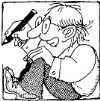|
ESL Forum:
Techniques and methods
in Language Teaching
Games, activities
and teaching ideas
Grammar and
Linguistics
Teaching material
Concerning
worksheets
Concerning
powerpoints
Concerning online
exercises
Make suggestions,
report errors
Ask for help
Message board
|
ESL forum >
Techniques and methods in Language Teaching > IPA symbols
IPA symbols
|

Antonio Oliver

|
IPA symbols
|
|
Hi all fellow teachers, I ďż˝d like to propose a topic for discussion: do you ever use phonetic transcription (IPA symbols) in your classes? Years ago it was part of the Spanish Language School Examinations but then it was removed from the syllabus. Personally, I ďż˝ve always found it fascinating that you can pronounce any word from any language, if you know how to "read" the symbols. Thank you, or in IPA transcription, ďż˝θďż˝nkju:
|
4 Aug 2017
|
|
|
|

Gi2gi

|
|
haɪ, ďż˝nˈtəʊnɪəʊ. jɛs, ipa ˈsɪmbəlz ɑː ˈvɛri ˈhďż˝ndi wɛn juː hďż˝v tuː tiːʧ ɔː lɜːn ə ˈlďż˝ŋgwɪʤ. ɪn fďż˝kt, wɛn aɪ wɒz ˈlɜːnɪŋ ˈɪŋglɪʃ, ˈɔːdɪˌəʊ məˈtɪərɪəl wɒz ˈvɛri skeəs ďż˝nd ďż˝i ˈəʊnli weɪ aɪ kʊd lɜːn prəˌnʌnsɪˈeɪʃən wɒz ipa ˈsɪmbəlz
:))))) :) |
4 Aug 2017
|
|
|
|
|

ldthemagicman

|
|
Antonio, I used to use IPA a lot, at first, but then I stopped. It has one HUGE advantage, but, unfortunately, several disadvantages ... the biggest being, that MANY computers, emails, PMs, etc. do not support IPA. No doubt, some computer �expert � on ESLP will advise us how to overcome this, by programming the computer appropriately. However, the average student often does not have the time, nor the technical ability, nor the permission to do this. When they arrived here, many of my students, especially poorly-educated students, were horrified that although initially they had learned their national language, (and often a local language also), they must now learn English. Here, in England, to write English, they had to learn 4 alphabets ... Capitals and Smalls in both Printed and Script form ... apart from reading numerous different Fonts. They struggled, but they learned them! And NOW, this Teacher wanted them to learn ANOTHER completely different alphabet, IPA, which looked like Greek, or Russian, and whose sounds were not EXACTLY the same as the English alphabet. A few succeeded, but the majority gave up. Because of this, I use a modified form of the �English Alphabet �, and give written explanations of the sounds. I use it in my Worksheets, and also face-to-face with Students. Many appear to find it helpful. However, to produce an accurate sound from the mouth is a complicated process for everyone. Even when the sound is played perfectly by the Computer to the Student, again and again, many find it extremely difficult to reproduce that sound. Some find it �impossible �. I will pose to you a question raised by a very competent Teacher, who writes to me: "How do you write a sound on paper?" Les Douglas
|
4 Aug 2017
|
|
|

temex

|
|
Hi Antonio! You �ve raised a question that I �ve sometimes asked myself, but I always come back to the same answer: no, I don �t use the phonetic symbols as it seems to be asking too much of the students. It �s enough of a challenge for most of them to learn English spelling and I �d feel embarrassed to ask them to learn what amounts to a new alphabet as well. Also, many of my students now have a talking dictionary on their cellphones; they just click on the word and hear it. Sure, the sound quality is pretty poor, but it gives them some instant idea of the sound. I �m afraid I don �t have an answer to your rather philosophical question, Les, ( "How do you write a sound on paper?") but on a practical level, I sometimes draw a diagram of the mouth and tongue to help students make consonant sounds. I wonder if anyone else does that ? I also have students hold their throats to discover if their vocal chords are vibrating or not. I don �t know how effective that is, but it always makes them laugh, so I plan to keep doing it regardless! |
4 Aug 2017
|
|
|

Jayho

|
|
Hi Antonio
I love IPA and I love using it. Students who know it, love it, and those who don�t, don�t.
For it to work, it really needs to be embraced by the institution and for all teachers to use it so that the students have several years of it. It�s no good just one or two teachers implementing it unless they have the students for a long time.
In one of my jobs it was compulsory and I loved it. Where I am now, most teacher�s don�t even know what it is. Our programs only last ten weeks so too short to teach it. My students are new adult migrants from many different countries and for those students who have learned it at school in their country (a handful), then I refer to it for them otherwise I don�t (except for schwa).
For books, I mainly used Ship or Sheep and Three or Tree by Ann Baker. Now I just use the board.
Les, you can use an IPA typewriter and then paste it into your document. Here are some typewriters
And here are some Cambridge activities, also available in the app store
Cheers
Jayho
|
4 Aug 2017
|
|
|

Antonio Oliver

|
Hi all, Thanks for the feedback -I confess the topic was more popular than I expected! Gi2Gi, ju: ɑ: ǝn ďż˝ekzpɜ:t, I mean, you are an expert! Les, agree, it ďż˝s like Russian! I ďż˝ve heard that comment many times. And it ďż˝s not every keyboard that will let you type in Russian, that ďż˝s also true Temex, a mouth diagram is way too good! I ďż˝ve never done that but maybe I ďż˝ll try. And yes, talking phones can do the job Jayho, thanks for the links, I think I ďż˝ll use them, You may laugh but in the past I ďż˝ve typed my transcriptions by pasting the symbols one by one, and that was after inserting them from Word!! I think we can agree that IPA symbols help... a) those students with a previous knowledge of / interest in transcription b) in the long(ish) run c) specially with words difficult to pronounce. For instance, my Spanish class can ďż˝t get "pleasure" or "treasure" right unless I explain the pronunciation of that "s" beforehand. Once they ďż˝ve got it right I simply tell them, "Well, the symbol for this sound is ʒ", so when we come across "unusual" I just have to ask them to pronounce "ʒ" in the middle Thanks guys
|
4 Aug 2017
|
|
|

Minka

|
|
We just have a look at the symbols so that the more able students get the idea. We use them a few times so that they can understand a bit how to pronounce a word if they look it up in a dictionary. Or if I want to point out (prove) that, for instance, apple is really pronounced ďż˝pəl and not eɪpl or something like that.
|
5 Aug 2017
|
|
|

kohai

|
|
Antonio, what an interesting topic! Thank you for starting it. Yes, I know, use and teach phonetic transcription to my students. Not in the first two grades when they have only one 40 min lesson per week and most of the time we spend listening, repeating, pointing, speaking, singing and playing games. In grade3 (three lessons per week), when I start to teach writing in English, they already can read and write in Latvian. Itďż˝s a big advantage for me because there are all English letters in Latvian alphabet except Q, W, X, Y. Of course, my students think they can read English too! My name is Ruta, and it is pronounced [ruta]. So, they read "this" as [this]. It ďż˝s time to teach them that writing and pronunciation in English differ in most cases. English has such sounds which are not in Latvian. The most difficult ones for us are [θ], [ďż˝], [ɜ:], [ŋ].
Every student takes one notebook (Vocabulary) only for new words, and almost each lesson we all together write into it some words this way: English Pronunciation Latvian An Example Sentence (in older classes, sometimes as homework) this [ďż˝i:s] ďż˝is; ďż˝ī This book is mine. I keep explaining while I am writing on the board and they are copying. I ask them to look and repeat. Sometimes I write the transcription first and ask them to try to read correctly. If they canďż˝t, I ask them to find in Vocabulary and point to the word which already contains the same sound. I keep encouraging and praising them. As homework, they have to learn to read and pronounce correctly 5-10 words. I NEVER ask them to learn the transcription by heart. I am surprised to find out that it had been included in exams in Spain. We use Oxford and Cambridge course books with vocabulary lists+phonetic transcription in them. I think that students have to know how to use dictionaries and I advise to buy only those which have Transcription in them. Mobile devices and apps can be useful too but not in all cases.
|
6 Aug 2017
|
|
|

Antonio Oliver

|
|
Thanks Minka, Ruta, So, a couple more conclusions: > Knowing the symbols can help students �pronunciation in general, and obviously when using a dictionary > Phonetic transcription is a quick tool when learning new words, but obviously at certain ages / levels of English I �d add one more: the symbols are a quick, useful way to teach how to pronounce some words especially when they don �t have a "normal" pattern (for example, "island" sounds ���Il�nd not ���Izl�nd as one would expect Yes, the Spanish Official School of Languages (Escuela Oficial de Idiomas, or EOI) used to include a Phonetics section in the annual grade exam, not an important part of the total mark, only 5% off the top of my head. In this section you had to: a) write 1 or 2 homophones (tail = tale) for some words given , b) write the IPA transcription for some words c) find some specific sounds in a text given Have a nice day,
|
6 Aug 2017
|
|
|